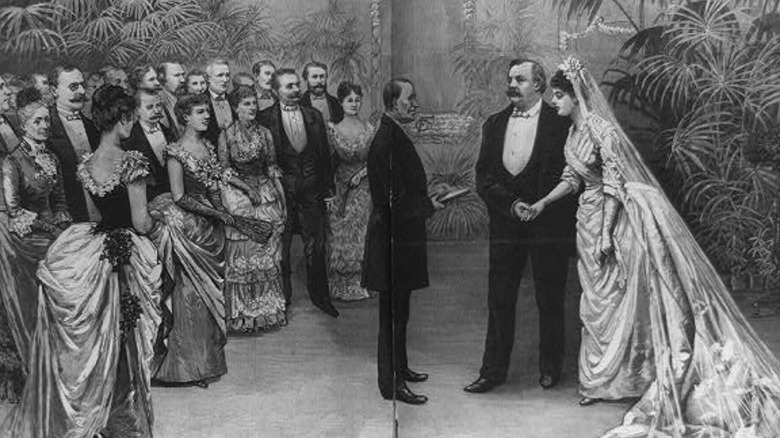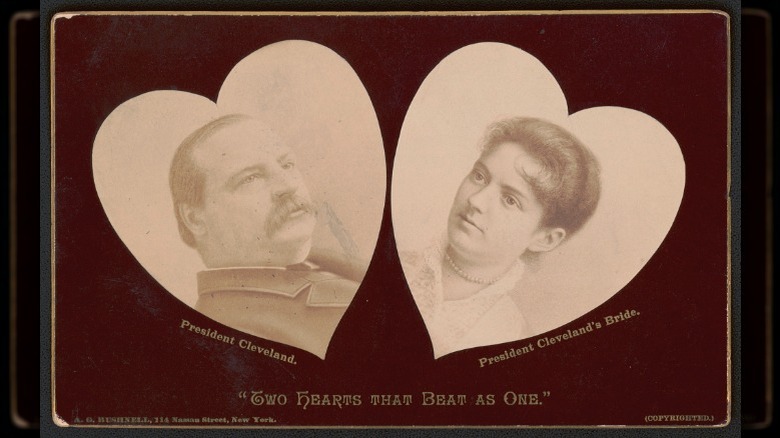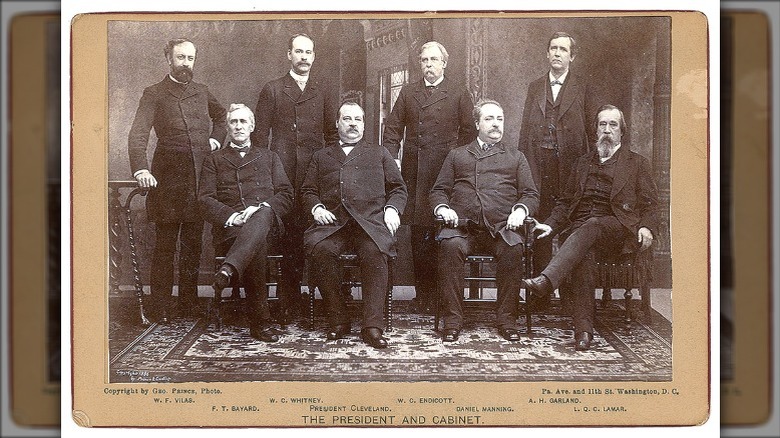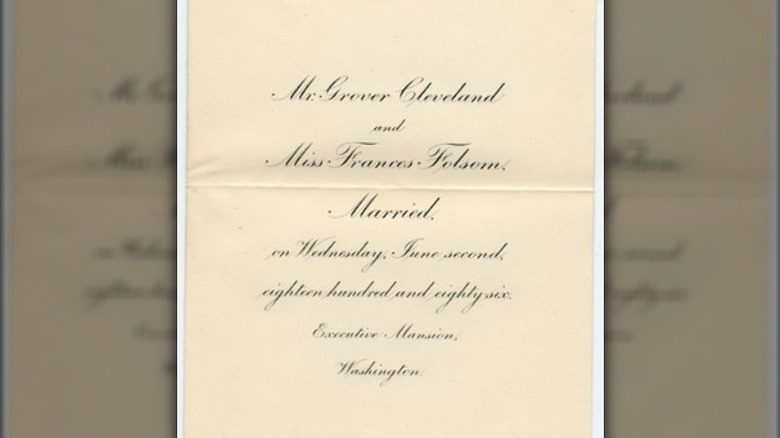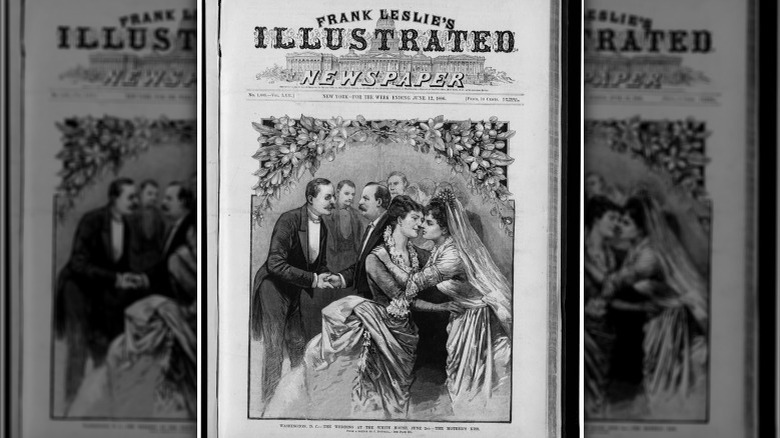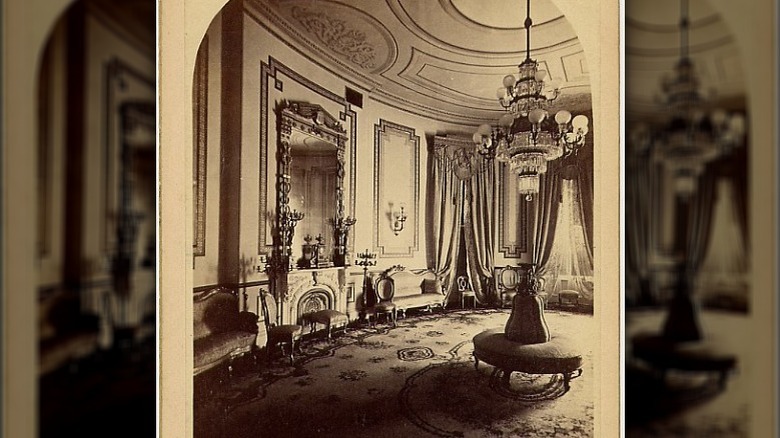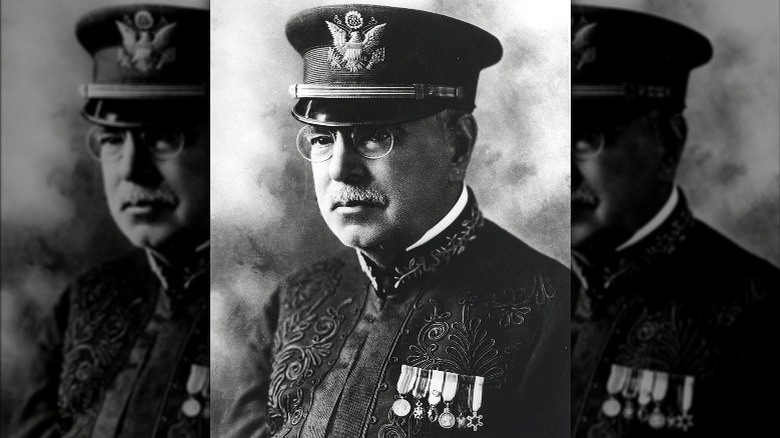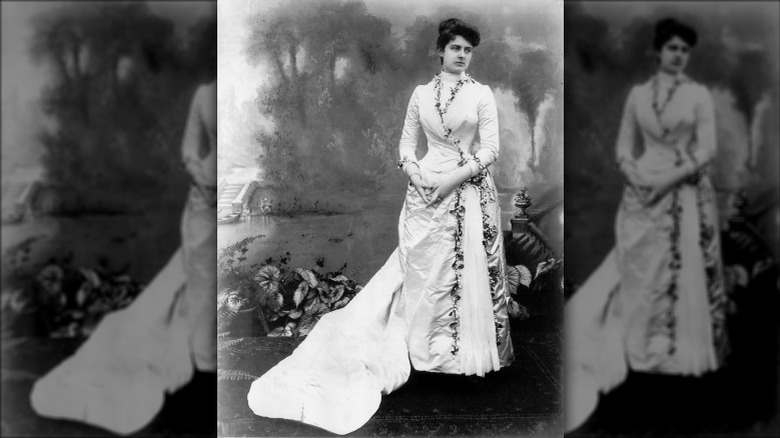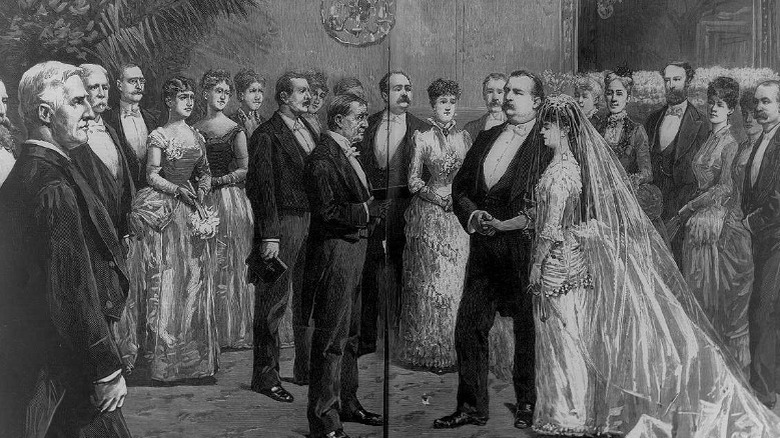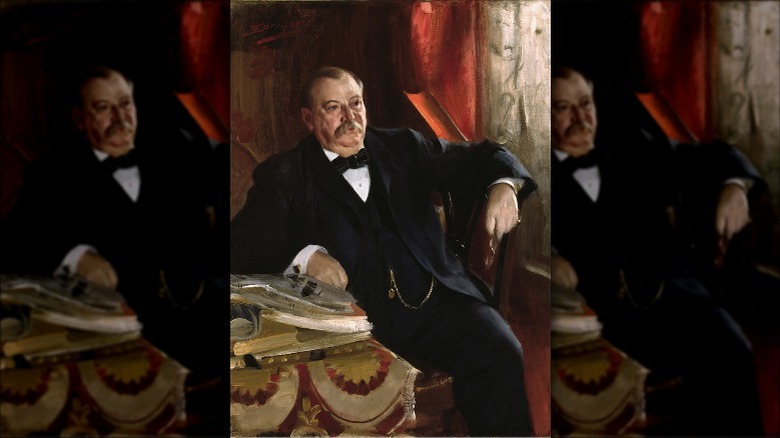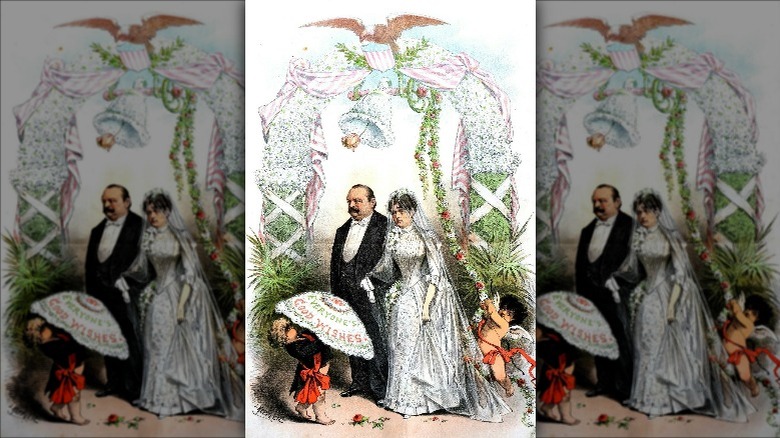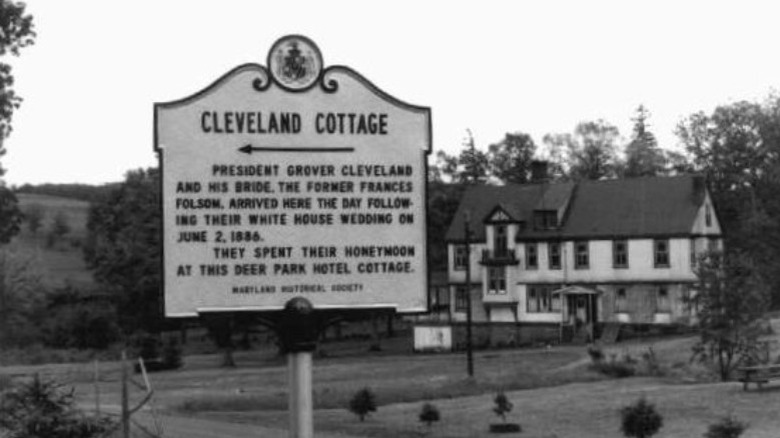What It Was Like To Attend The Only Presidential Wedding In The White House
Since the politicians in Washington, D.C. always seem to be worrying about the deficit, here's an idea for how to plug the gap in the country's finances: Rent out the White House as a wedding venue. Think of it, happy couples all over would clamor to have their special day in the building that is probably the closest thing the United States has to a royal palace. There's even a room to match every bride's chosen color pallet. (The sales pitch writes itself: "Green? Blue? Red? Whatever your accent color, the White House has the room for you!") The place is big enough you could book multiple weddings at a time, every day all year round. The money would come flooding in.
A lucky and exclusive group have gotten married at the White House, most of whom were children or grandchildren of the sitting president. But when it comes to presidents themselves getting married in the Executive Mansion, the perfect storm of politics, pomp, and romance, there is just one single example. President Grover Cleveland – most famous for being the lone president to serve non-consecutive terms – was also the only one to have a presidential White House wedding.
The wedding date was June 2, 1886, and the bride's name was Frances Folsom. So if you'd been around back then, and also been besties with the president, and you managed to score an invite to this historically notable social event, what would the experience have been like?
The guests might have been a bit judgmental of the match
In 2019, CNN anchor Jack Tapper tweeted about Grover Cleveland's marriage, calling it "quite disturbing" and "very sick." Cleveland doesn't seem like he would excite that kind of passion, so what was Tapper so upset about?
Well, here's the thing. If you were a guest at President Cleveland's wedding, you'd know you were about to watch him marry a woman 27 years younger than him, who he had known since she was literally a baby. Not only that, but according to the White House's biography on Frances Folsom Cleveland, when she was just 11 years old, her dad died, and Cleveland became an administrator of his late law partner's estate. The biography takes pains to point out, however, that Cleveland was "never her legal guardian." Which, you know, makes the fact he was marrying the person to whom he gifted her first baby carriage after she was born not weird at all.
If you're thinking, well, things were a bit different back then, even at the time this situation got a "wait, what?" from most people. In fact, History says that once the press caught on to the fact Cleveland was involved with someone, everyone assumed it was Frances' mother, who was not only much more age-appropriate but an old friend of the president. It was genuinely shocking to the public that instead, Cleveland was marrying a girl of only 21, whom he'd treated almost like a daughter her whole life.
There were only a select few guests
You'd think that if you had the chance to get married in the White House, you'd want to invite everyone you knew. Even the kids who were mean to you decades before, just to be like, yeah, look at me marrying and/or being the president. Not so for the Clevelands. History says only 28 guests were invited to their wedding, just close family, a few friends, and the president's Cabinet.
As you can see from this picture of Cleveland with his first cabinet, who would have been the group invited to the wedding, it might not have had the makings of the most exciting party ever. These are not guys you can expect to see doing wooden keg stands and forcing the Marine Band to play "just one more" until the sun comes up. Plus, why would you invite so few people and then half of them are guys you work with? But for the president, the people who made even worse wedding guests than his employees were their wives. The Shapell Manuscript Foundation has a letter Cleveland wrote to his fiancé six months before they were married while she was in Europe, where he complains about having to attend the parties and social events that "the Cabinet ladies" will put on. It seems like the Cleveland wedding was definitely not most modern brides' dream day.
Amazingly, the wedding was bigger than Cleveland wanted it. The foundation notes that originally, he wanted "a quiet private ceremony" and only did the White House wedding so Frances could have something fancier.
The guests were invited very last-minute
If you were invited to the first (and still only) wedding of a sitting president of the United States to take place in the White House, you'd want some time to prepare. There's a new outfit to buy, first off. Considering Frances Folsom had only just returned from the better part of a year in Europe, of which a decent chunk was spent getting a custom-made wardrobe, as a guest you'd want enough notice to pick a designer, have your look designed and tailored, and travel to and from a foreign country if necessary.
For Grover Cleveland's marriage, they got five days' notice. The Shapell Manuscript Foundation has a handwritten wedding invitation President Cleveland sent to his postmaster general William Vilas. It is just two lines, saying he's marrying Miss Folsom next week and that it would be "a very quiet wedding, but I earnestly desire that you and Mrs. Vilas will be present on the occasion." Also included with the note was an official printed wedding invitation that, if anything, was even more to the point and devoid of any decoration.
The president had been very strict on secrecy around his relationship with Frances Folsom, at least in part because even he knew what their relationship was going to look like to the public: a bit weird and icky. So if you were one of the few who got an invite, you probably were just as shocked as everyone else the wedding was happening, and that it was in less than a week.
Guests could not speak to the press
While the guests might have felt five days wasn't enough notice for such an illustrious wedding, the press had no problem getting on top of the situation immediately. Overnight, the event was surrounded by the kind of headlines and breathless anticipation that you'd expect from a celebrity wedding today.
On the actual wedding day, the press was ravenous. The National First Ladies' Library says the press gave the bride the nickname "Frankie" (although she really went by Frank, thank you very much) and made her a fashion icon from the get-go. Grover Cleveland had realized his fiancé would be an object of interest, but the resulting obsession shocked him. As soon as Frank landed in New York from Europe, she was followed by reporters right to the threshold of the White House on her wedding day. The press was so desperate for information on the wedding to relay to their readers, there were even articles about the factory where the box for the wedding cake was produced. The press didn't let up after the wedding, either, with interest in the new Mrs. Cleveland so great that the president worried public events were too dangerous for her.
The day after the wedding, the New York Times published a five-column story on the event, down to the most mundane details, especially on everything the bride did before the ceremony. They listed each guest as they arrived, however, the National First Ladies' Library says those lucky few who were invited all refused interviews, as you would assume the president instructed them.
The decorations
The couple was married in The Blue Room, which the White House Historical Association says was designed by the architect to be the fanciest room in the Executive Mansion. The oval room was (and still is), as you might expect, quite blue. And it had been refurbished only four years previously by the famous designer Louis Comfort Tiffany. The furniture had been replaced with new, fashionable pieces two years before that. It was the perfect location for the ceremony.
Maybe it's because the only part of the wedding that journalists were allowed to see was the floral decorations before the ceremony, but The New York Times was really, really obsessed with the flowers in their full-page article on the wedding. Like, weirdly so. What they definitely want you to understand is: they got to see the flowers, and they were just, like, so pretty. Also, they were everywhere, covering every flat surface and draped on any surface that was not flat. Even the chandeliers were entwined with flowers. Mirrors were covered in vives. Palm plants of varying sizes (and don't worry, they go into detail on those sizes) were seemingly coving every inch of the floor, making one wonder where the guests stood. And those guests would be forgiven for thinking that there had been a mix-up, and the wedding was taking place in a greenhouse in the middle of the jungle.
The decorators got to be creative with the flowers as well, spelling out the wedding date, the couple's initials, and "E Pluribus Unum."
The music
While everything about the wedding was simple, the Clevelands at least had the luck to be getting married at the same time that famous conductor and composer John Philip Sousa (pictured) was director of the Marine Band. Other than the event taking place at the White House, having the king of the military march in charge of the music at the ceremony and reception, as People reports, was the most impressive thing about the day.
White House Weddings says the president was obviously acutely aware of how his marrying his much younger ward was going to look, and if you aren't convinced of that yet, his reaction to an original composition by Sousa for the wedding should erase all doubt. Sousa titled the piece "Student of Love." Seems like a harmless enough title for the quartette, but the president crossed it out and changed the name to ... "Quartette." Considering Frances Folsom was an actual child when Cleveland first knew her, and that she was literally a student at Wells College when he asked her mother for permission to start a romantic correspondence with her (he also used to fill her dorm room with flowers and had a special railroad track laid down to make it easier for him to go visit her) any connotation of her being young – too young – needed to be avoided.
The New York Times also had a story that a member of the public tried to bribe John Philip Sousa with $50, a not-insignificant amount of money at the time, to dress him up like a member of the band and sneak him into the wedding ceremony. Sousa refused.
The bride was beautiful
Frances Folsom was considered a very beautiful woman in her day. Less gallant people might say this was one of the reasons Grover Cleveland wanted to marry her as opposed to her much plainer mother. The White House records that her obvious good looks were even used by one of Grover Cleveland's political foes to illustrate how much he hated the president: "I detest him so much that I don't even think his wife is beautiful."
The press went all-in on Frances as a fashion star, starting before the wedding. On the day itself, the New York Times wrote that the soon-to-be Mrs. Cleveland (pictured in her wedding dress) was so gorgeous as to stun her guests: "Accustomed as were the ladies gathered in the Blue Room to the dazzle of rich costumes, they could barely restrain expressions of wonder and admiration at the beautiful picture presented by the bride."
According to the White House Historical Association, her dress matched the overly-floral room with its trim of laurel and orange blossoms (after Queen Victoria wore orange blossoms to marry Prince Albert, no self-respecting Victorian bride would be without), and the satin and silk creation was so stiff that reports said it would stand up by itself (this was, apparently, a good thing). It's believed the dress was the creation of Charles Frederick Worth, an English couturier living in Paris who was the most exclusive fashion designer of the day. The dress was topped off by a 6-foot train.
'A very simple service'
A letter from Grover Cleveland to Frances Folsom held by The Shapell Manuscript Foundation that he sent less than two weeks before their planned wedding date shows that it almost didn't happen. While she was on the boat back from Europe, the first-lady-to-be's grandfather died. This would have been a perfectly acceptable reason to delay the wedding, but it's clear from the letter that the president really, really didn't want that. While he keeps reassuring Frances it's her decision, he then basically makes the decision for her.
Cleveland also seems to have planned the entire wedding himself, which makes sense, since his bride had been on a different continent for nine months and only got back days before the event. The president wrote that the wedding could be scaled down even further than originally planned because of her grandfather's death, saying they could "reduce it to a very quick affair indeed." It seems they did that, as the New York Times report on the wedding called it "a very simple service." It was Presbyterian, the religion of both the bride and groom.
The fact it was over quickly was perhaps preferable for the guests, as the newspaper explains none of them were given chairs, except for the Secretary of the Treasury Daniel Manning, "on account of his invalid condition," but he didn't use it.
The president was all business, all day
A little thing like getting married to the girl you have known and loved since she was an infant should not get in the way of the important work of being president of the United States. Or so thought Grover Cleveland, apparently. According to History, he did not take his wedding day off of work.
The New York Times noted that he woke up at 5:30 am and spent a "long and busy day" working on official tasks that apparently just could not wait, although he did manage to get a walk in as well.
That evening, the president finally appeared, dressed in a tuxedo and white bowtie. Coming straight to his own wedding from the "office," as it were, Cleveland may not have had time to get into the role of a blushing bridegroom, as he was completely unaffectionate to his bride during the ceremony. They didn't kiss after they were joined as man and wife, and he didn't even show any affection towards her during the rest of the ceremony, according to White House Weddings. Reading some of the letters Cleveland sent his bride-to-be in the months before their wedding, while she was traveling in Europe and they had been apart for a long time, you'd have no idea he would be so emotionless at his wedding. In missives to Frances held by the Shapell Manuscript Foundation, he comes across as extremely passionate, but guests at the ceremony would have had no idea.
The reception
Technically called the "wedding feast" by the New York Times in their contemporary coverage, the reception was held in one of the formal dining rooms down the hall from the Blue Room. The newlyweds and their guests walked there immediately after the service. There were small tables for the guests, but no seating chart, as they picked the table they wanted. The courses included "terrapin and a lot of dainty French dishes, of which no one knew the name," but apparently it was all very tasty. There was also a wedding cake. The New York Times says it was all very casual and joyous, and included toasts to the happy couple.
In case you were worried, there were flowers all over the reception room too. In the middle of the main table was an elaborate floral sculpture, with the flowers in the shape of a ship named "Hymen," which, of course, is the name of the Greek god of marriage ceremonies, and not what you were thinking. There were lots more flowers and plants too, which the paper went into excruciating detail on.
The most exciting thing that happened at the reception, according to Landmark Events, was when a telegram arrived from England, with no less a person than Queen Victoria offering the couple her congratulations on their nuptials. The dinner only lasted about an hour, before President and Mrs. Cleveland went to get ready to leave on their honeymoon. The guests wandered around the White House while they waited for them.
Sent off on their honeymoon
As the press were still eagerly waiting around the White House after the wedding reception, Overton County News reports the president decided to use his guests to throw them off. Two wedding guests were sent off in a decoy carriage, which lessened the press scrum enough to allow the newlyweds to get off to the train station.
But first, the guests had a bit more fun. The tradition of throwing rice at a wedding has been around a long time, and if you've been to a few, you might also have tied old shoes to the back of a newlyweds' car along with some cans and a "Just Married" sign. President and Mrs. Cleveland were also treated to a shower of rice, but as the first car had only just been invented, the guests threw the old shoes at the bride and groom as well, according to the New York Times.
Cleveland was very excited to spend alone time with his new wife, writing her less than 10 days before the wedding (via the Shapell Manuscript Foundation), "I know that you will be glad to hear that I have made arrangements for us two to go away immediately after the ceremony and be together for a week." He'd selected a cabin at Deer Park Lodge in the Catoctin Mountains of Maryland, about 200 miles from Washington, D.C., in an isolated area. But Landmark Events says the press besieged the couple there as well and effectively ruined the honeymoon, something Grover Cleveland held against them the rest of his life.
